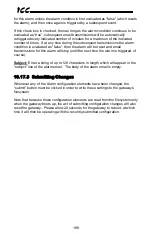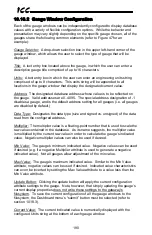
201
ICC
11.3.2
BACnet/IP and BACnet MS/TP Client
11.3.2.1
Overview
The gateway supports BACnet IP client on its Ethernet port and BACnet MS/TP
client on its RS-485 port. Some notes of interest are:
•
The gateway supports reading and writing the present value property of
BACnet objects in devices on the network.
•
Requests are fully configurable through service objects.
•
Supported BACnet objects include:
o
Analog Input
o
Analog Output
o
Analog Value
o
Binary Input
o
Binary Output
o
Binary Value
•
Supported MS/TP baud rates include:
o
4800
o
9600
o
19200
o
38400
o
57600
o
76800
o
115200
•
MS/TP static device binding is supported.
11.3.2.2
BACnet Service Objects
The BACnet Client protocol uses service objects to describe what services the
gateway should perform. For each service object, the gateway will continually
read the present value of the defined BACnet object within the service object
from the designated device, storing the value(s) in the database (if the read
function is enabled). When data in the database changes where the BACnet
objects are mapped, a write request is generated to the designated device
notifying it of the changed present value(s) of the BACnet object(s) (if the write
function is enabled). For more information on configuring BACnet MS/TP service
objects, refer to section 8.8.3.3. For more information on configuring BACnet/IP
service objects, refer to section 8.7.2.2.
11.3.2.3
Device Binding
Dynamic Device Binding
(MS/TP only) In order for a BACnet client to request data from other devices, it
must first learn what addresses those devices are located at on the network.
BACnet client devices can use dynamic device binding to learn the addresses of
other devices on the network. This is done by sending a Who-Is request on the
network. Any devices whose device instance falls within the range of the Who-Is






























